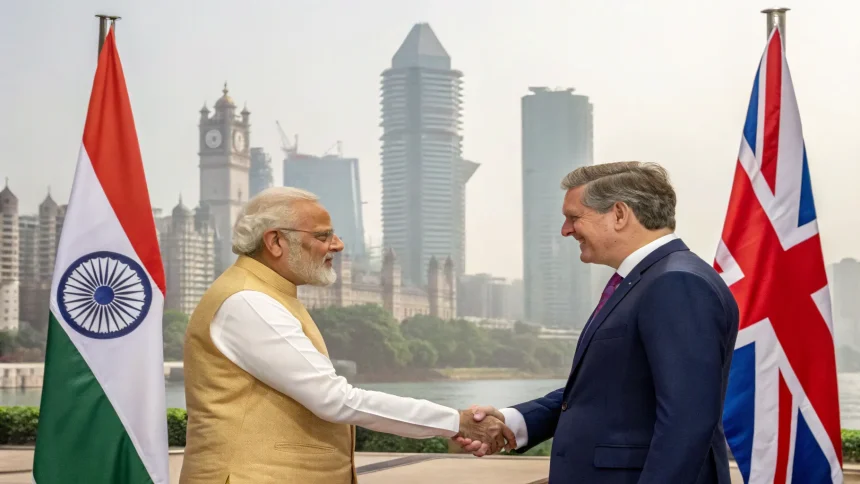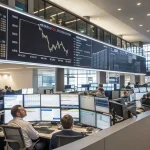India and the United Kingdom moved their trade talks back into focus as Prime Minister Narendra Modi met British Prime Minister Keir Starmer in Mumbai. The leaders used the meeting to push for progress on a proposed Free Trade Agreement and to widen cooperation in technology, security, and culture. Their discussion signaled intent to close gaps on trade while building a broader partnership with long-term goals.
Background on the FTA Talks
India and the UK launched FTA negotiations in early 2022, seeking to boost goods and services trade. Talks have progressed through several rounds, but final terms remain open. Changes in the UK government in 2024 added new political dynamics, while India continued to weigh domestic industry concerns.
Both sides have said an agreement could lift exports and investment. The UK has sought lower tariffs on cars and spirits, while India prioritizes market access for services and mobility for professionals. Data protection, digital trade, and rules-of-origin have also featured in the talks.
The timing matters. Britain is looking to expand trade links after Brexit. India wants to grow manufacturing and attract advanced technology. The diaspora in the UK, estimated in the millions, adds social and economic ties that shape policy choices.
Leaders Signal Wider Cooperation
The leaders emphasised deepening strategic partnerships and boosting economic, cultural, and technological cooperation between the two nations.
Officials present framed the meeting as part of a steady push to convert political goodwill into deals. Energy transition, digital public infrastructure, and startup links were cited as priority areas. Education and research partnerships also drew attention, given strong student flows and university ties.
Both governments highlighted security cooperation. Maritime security in the Indo-Pacific and joint defense research have advanced in recent years. The meeting reiterated interest in co-development and co-production, which could create jobs while meeting defense needs.
Economic Stakes and Industry Impact
Business groups on both sides have pressed for predictable rules and lower trade costs. A well-structured FTA could reduce duties on key goods and clarify standards for services firms. It could also set mechanisms to resolve disputes faster.
- UK exporters seek tariff cuts on automobiles and Scotch whisky.
- Indian firms seek easier visas for professionals and recognition of qualifications.
- Tech companies want clear data rules and support for digital trade.
Economists say a deal that improves logistics and customs processes may unlock as much value as tariff cuts. Small businesses could benefit from simpler paperwork and better market information. Investors are watching for signals on intellectual property, public procurement, and sustainability standards.
Points of Convergence and Hurdles
There is clear alignment on innovation. India’s digital systems and the UK’s finance and research sectors form a strong match. Clean energy supply chains, including green hydrogen and critical minerals, offer shared opportunities.
But differences remain. Tariff demands on sensitive goods are hard to bridge. Mobility is politically sensitive in the UK, while market access for agriculture and dairy raises concerns in India. Data rules need careful drafting to protect privacy and enable trade.
Discussions centred on trade, the proposed Free Trade Agreement, and collaboration across sectors, with both sides seeking to strengthen India-UK ties.
Negotiators have looked at phased reductions and safeguard clauses to manage adjustment. Clear timelines and review mechanisms may help build confidence.
What Comes Next
Officials will now seek to convert high-level direction into technical progress. That means narrowing lists of contentious items and setting deadlines. Stakeholder consultations are expected to continue with industry, universities, and civil society.
Both leaders have incentives to show movement. For India, a balanced deal could support growth and jobs. For the UK, it would mark a major trade pact with a large economy. Any agreement will still face legal review and political scrutiny in both countries.
As one official put it, the goal is practical: reduce trade friction, support innovation, and deepen trust. The meeting in Mumbai signaled that the political will is there. The test will be landing a fair deal that works for workers, consumers, and businesses on both sides.
In the weeks ahead, watch for updates on tariff schedules, services access, and digital trade rules. These details will show whether the two governments can translate broad alignment into a signed pact with clear benefits.







